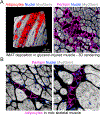Fibro-adipogenic progenitors in physiological adipogenesis and intermuscular adipose tissue remodeling
- PMID: 38788527
- PMCID: PMC11692456
- DOI: 10.1016/j.mam.2024.101277
Fibro-adipogenic progenitors in physiological adipogenesis and intermuscular adipose tissue remodeling
Abstract
Excessive accumulation of intermuscular adipose tissue (IMAT) is a common pathological feature in various metabolic and health conditions and can cause muscle atrophy, reduced function, inflammation, insulin resistance, cardiovascular issues, and unhealthy aging. Although IMAT results from fat accumulation in muscle, the mechanisms underlying its onset, development, cellular components, and functions remain unclear. IMAT levels are influenced by several factors, such as changes in the tissue environment, muscle type and origin, extent and duration of trauma, and persistent activation of fibro-adipogenic progenitors (FAPs). FAPs are a diverse and transcriptionally heterogeneous population of stromal cells essential for tissue maintenance, neuromuscular stability, and tissue regeneration. However, in cases of chronic inflammation and pathological conditions, FAPs expand and differentiate into adipocytes, resulting in the development of abnormal and ectopic IMAT. This review discusses the role of FAPs in adipogenesis and how they remodel IMAT. It highlights evidence supporting FAPs and FAP-derived adipocytes as constituents of IMAT, emphasizing their significance in adipose tissue maintenance and development, as well as their involvement in metabolic disorders, chronic pathologies and diseases. We also investigated the intricate molecular pathways and cell interactions governing FAP behavior, adipogenesis, and IMAT accumulation in chronic diseases and muscle deconditioning. Finally, we hypothesize that impaired cellular metabolic flexibility in dysfunctional muscles impacts FAPs, leading to IMAT. A deeper understanding of the biology of IMAT accumulation and the mechanisms regulating FAP behavior and fate are essential for the development of new therapeutic strategies for several debilitating conditions.
Keywords: Adipocytes; Adipogenesis; FAPs; IMAT; Metabolism; Obesity; Skeletal muscle.
Copyright © 2024 The Authors. Published by Elsevier Ltd.. All rights reserved.
Conflict of interest statement
Declaration of competing interest The authors declare that the research was conducted in the absence of any commercial or financial relationships that could be construed as potential conflicts of interest.
Figures




References
-
- Agley CC, Rowlerson AM, Velloso CP, Lazarus NR, Harridge SD, 2013. Human skeletal muscle fibroblasts, but not myogenic cells, readily undergo adipogenic differentiation. J. Cell Sci. 126 (Pt 24), 5610–5625. - PubMed
-
- Akima H, Yoshiko A, Hioki M, Kanehira N, Shimaoka K, Koike T, Sakakibara H, Oshida Y, 2015. Skeletal muscle size is a major predictor of intramuscular fat content regardless of age. Eur. J. Appl. Physiol. 115 (8), 1627–1635. - PubMed
Publication types
MeSH terms
Grants and funding
LinkOut - more resources
Full Text Sources
Miscellaneous

